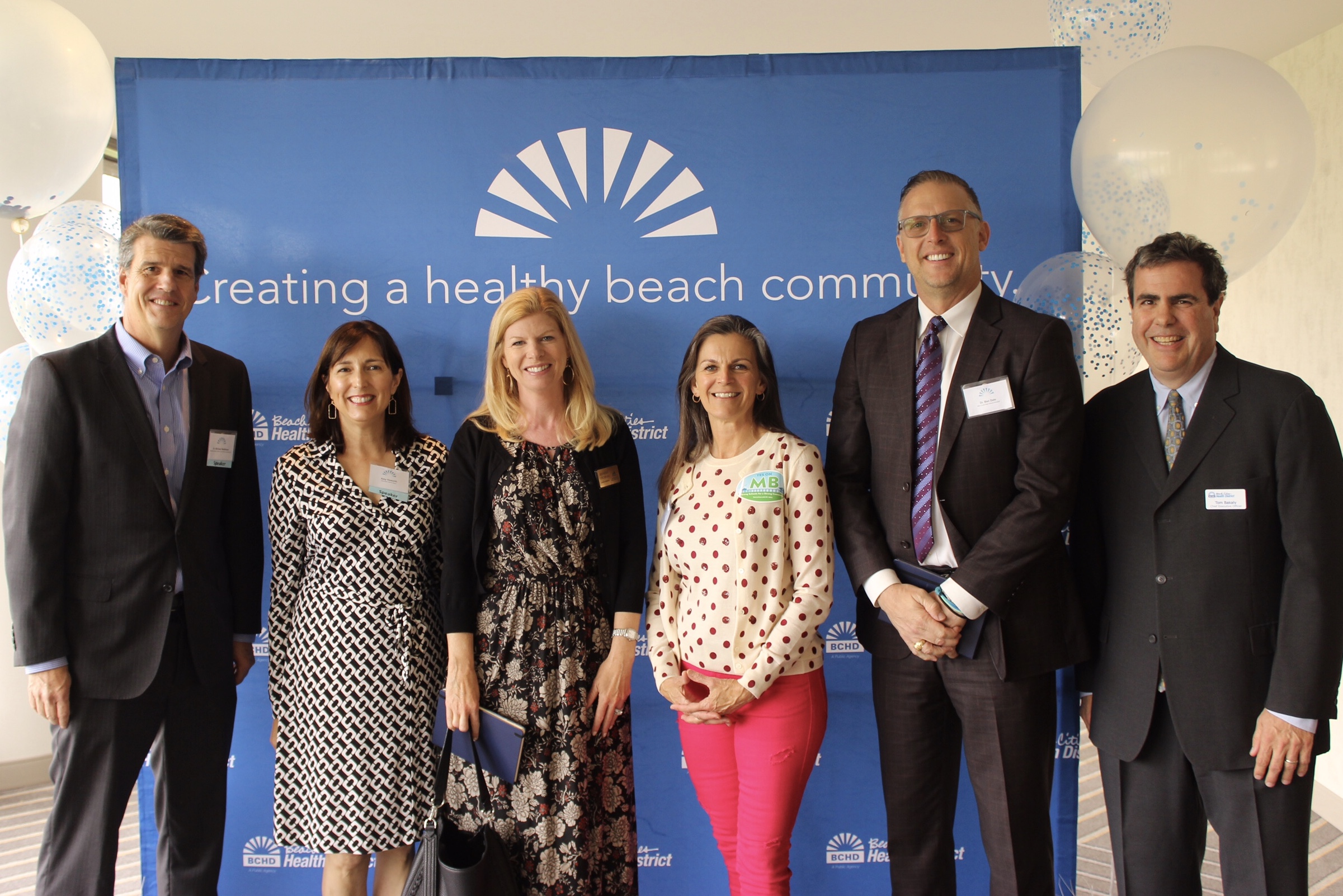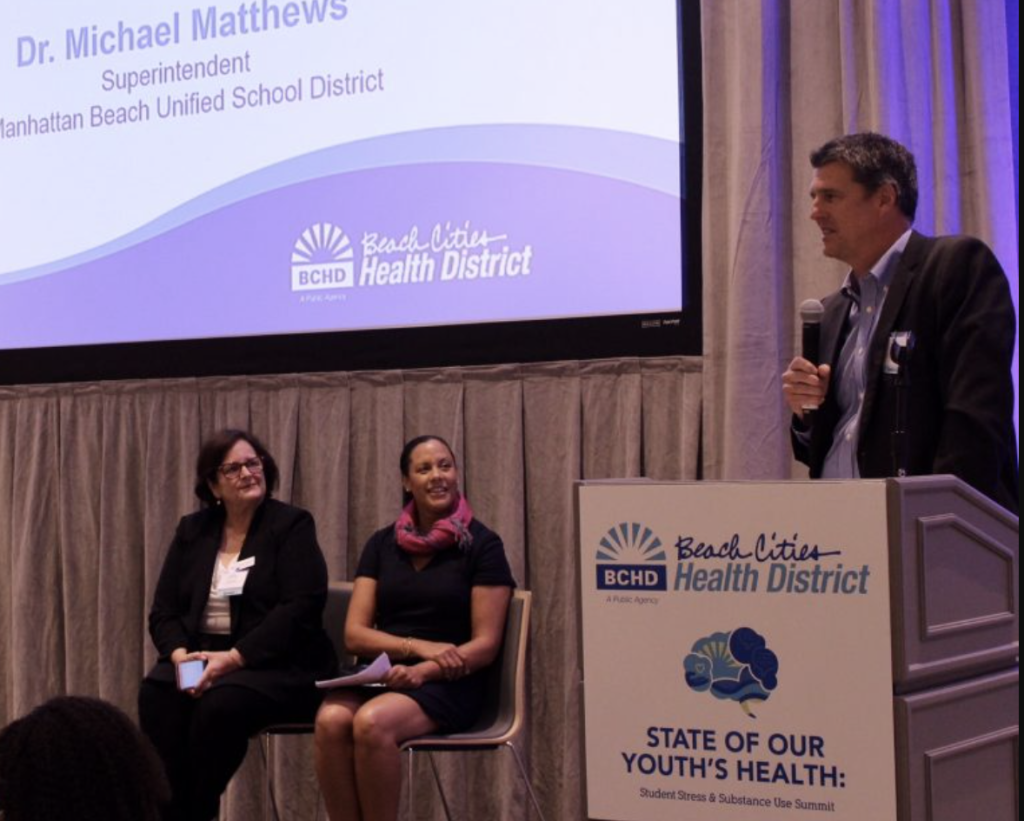May 24, 2018
I had the honor of attending an amazing event in our community today. Beach Cities Health District sponsored a Summit on Youth Stress and Substance Abuse. This is a huge issue for our community, for the communities of the Consortium 2030 group, and for the nation as a whole. We heard from 12 students in our local middle and high schools. They spoke about stress, the value of teachers knowing them well, the amount of vaping that is permeating teen culture and our schools, and so much more. They were great. One of my favorite comments was from a student who said, “I am expected to do the best I can, actually, to do more than the best I can.” We heard from former US Representative Mary Bono Mack, who shared stories addiction in her family, and gave ideas for how we can work together to support individuals and families in crisis. It was a powerful summit, and I am grateful for being able to participate.
Along with our other local superintendents, I was asked to make remarks at the summit. Here is what I shared.
—–
 I had a beautiful start to my day today. Fifty-one graduating seniors, their parents, and their Meadows Elementary School teachers reunited on the Meadows Elementary School cafeteria. There were tears, smiles, laughter, and comments about how the teachers used to be taller. It reminded me of the joy of friendships, of powerful teacher-student connections, and of a community celebrating together.
I had a beautiful start to my day today. Fifty-one graduating seniors, their parents, and their Meadows Elementary School teachers reunited on the Meadows Elementary School cafeteria. There were tears, smiles, laughter, and comments about how the teachers used to be taller. It reminded me of the joy of friendships, of powerful teacher-student connections, and of a community celebrating together.
It was a great lead in to this amazing summit, as we work together to make life for our youth healthier, safer, and happier.
This is a powerful room of people actively seeking to improve social emotional wellness, diminish stress, and end substance abuse with our youth. Some people in the room are interested in learning more, a few may be skeptical, most are concerned, some have devoted their professional and personal lives to this cause, and some are here full of pain from the suffering or even the loss of loved ones. That’s the range of people we have in this room and in our schools.
I want to thank Beach Cities Health District for sponsoring this summit and for helping to start this conversation. The original Blue Zones report made it clear that our communities are stressed places. It does not look that way on the surface. I heard someone say that we are like ducks. We look all nice and peaceful, but underneath the water, we are paddling like hell, going somewhere in a hurry or just trying to stay afloat. We are a stressed community, and our kids feel it. I’m a parent of two young men, ages 27 and 15. I’m an educator for the near 7,000 students in the Manhattan Beach School District. I join all of you in trying to find that right line between encouraging, pushing, caring, and unconditionally loving our own children and the children of our community.
Our students are stressed. Read Denise Pope’s book, Overloaded and Underprepared. Read Frank Bruni’s book, Where You Go Is Not Who You’ll Be. Students are stressed about college. Parents are even more stressed about college. They burden themselves with loads of classes that are often just too much. Go to Families Connected meetings, sponsored by amazing parents like Laura McIntyre. Our students don’t sleep enough. They worry that their lives may not be as interesting as what they see on their social media feeds. They witness people being mean to each other and to them. Our students are certainly stressed.
On the other hand, our students have joyful experiences as well. I saw it this morning. Last week, I got to see our choir singing joyfully in Disney Hall. I see it with students in marching band performing on the field, or in an amazing musical, or on a sports team achieving a new personal record, or on the robotics team, or in a class they love smiling because of what they learn and how they are learning it. One senior last night admitted to an auditorium of parents and students, “I’ll say it, I love math and I thank Mr. Chou for making me love it in 5th grade!” I see that joy when I shadowed students and witnessed the power of friends reconnecting at lunch, at nutrition breaks, or just saying hello in the hallway.
It’s not all darkness out there. There is a lot of light, as evidenced by their joy and smiling.
How do we help that power of light to prevail over the dark powers of stress, sadness, and anxiety? Because when that power of light and joy does not prevail, that’s when substance abuse sees an opening. And it will jump at that opening.
What can we do to help our students succeed with the right amount of stress? How can we help the light to prevail?
I’m a big believer in the concept of Flow. I even read Mihaly Csikszentmihalyi’s book and understood at least half of it. Here’s what I do understand about flow. There is no better time to be alive than when you are so immersed in something that time ceases to exist. For me, that can be moments with family and friends, bicycling, cooking, learning something new, reading, swimming, golfing, in a fascinating conversation, in a high-quality meeting, solving a complex problem, and many other times. In those times, there is no worry about anything. The next thing is nowhere in your mind.
I want us to create more opportunities for flow in our children’s and our students’ lives. I want us to have it in our lives!
One way we are trying to make that happen in MBUSD is by having students experience more Personalized Learning. When I was in school, memorization was the key to success. And I was pretty good. I still know the quadratic formula. I can still integrate calculus problems. I still know that there are 6.02 x 1023 molecules in a mole. I have no idea how to apply any of those things. With that type of memorization-centric teaching, who needs personalized learning?
But with the advent of the smart phone and technology all that knowledge is one button away. Some still argue with that. But many of us in this room used to know 40 phone numbers, now we are lucky to know 3. Does that keep us from talking on the phone? OK, does it keep any of us from texting?
Schools are no longer the repository of knowledge to be imparted unto students. We must be coaches, mentors, and we have to know our students. We need to teach them skills that can help them learn and succeed. We can help our students to grow and find their flow. Teaching has a whole new meaning these days, and it is more challenging than ever.
That’s what our social emotional wellness movement is all about in our schools. We are looking for ANYTHING we can do to chip away at student stress. We are looking for anything we can do to connect and help our students lead healthy productive lives. Here is what we are working on:
- How do we make homework meaningful and never busywork, and not assign so much that our students have extreme burdens outside of school?
- How do we create school schedules, block schedules, that make it easier on students to thrive each day?
- How do we use counselors, classroom teachers, advisories, and more to help students connect with adults who care?
- How do we create academic experiences that are appropriately challenging for each child and as meaningful as possible?
- How do we convince parents and students that life will be OK, in fact our students will thrive, even if they choose to go to a college not ranked at the very top?
- How do we convince our students and parents that taking too many classes can suck the joy and health right out of students’ lives?
- How do we help our students to care for themselves and their brain health by getting enough sleep each night?
- How do we encourage inclusiveness in our community, where everyone feels welcome, and no one feels isolated or attacked?
- How can students include classes into their high school schedules that create a space where they can be joyful, pursue what they love, and experience flow each and every day?
That’s what we are trying to do in our schools. These are the questions our board is trying to figure out. We are working with students, parents, BCHD, our partner districts, our local therapists and health community, and anyone who cares. Some of you who are in the room with me know that not everyone believes the way we do. But I believe it, and I know you do too.
Everything we can do, every positive change we make, big and small, they all diminish the need for coping mechanisms like substance abuse and bullying, and they all increase our students’ potential for joy and flow.
That’s what we are all trying to do. We are not there yet. But our summit should remind us all that we are not alone and we are not giving up.
I thank each of you for every effort you make to help us in this quest.

I’m joined by Manhattan Beach Mayor Amy Howorth, MBUSD Board Members Jen Cochran and Ellen Rosenberg, Mira Costa Principal Ben Dale, and BCHD Chief Executive Officer Tom Bakaly.
